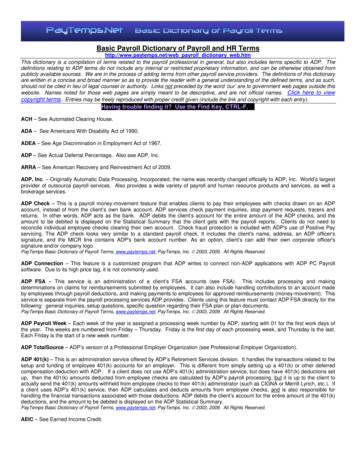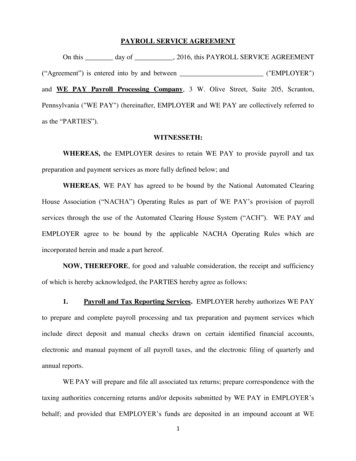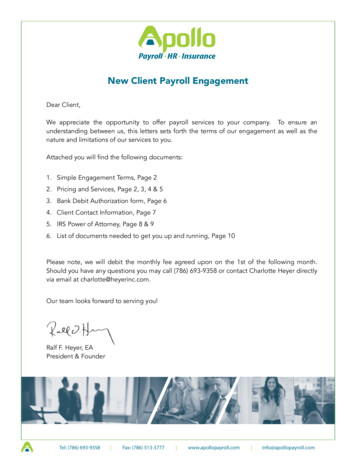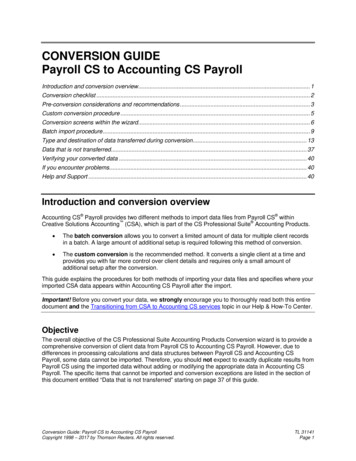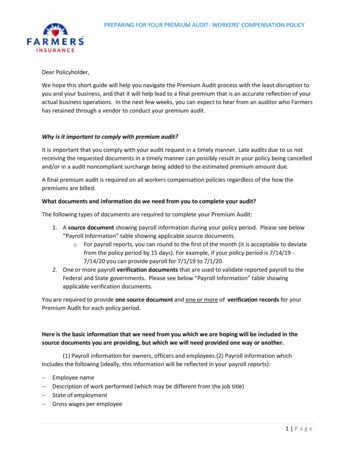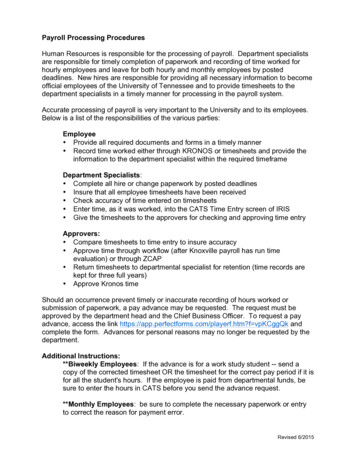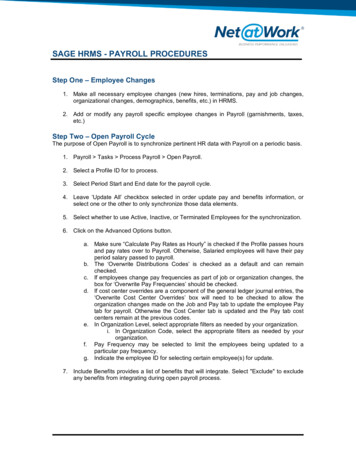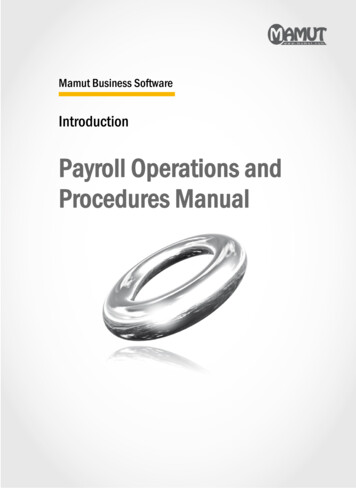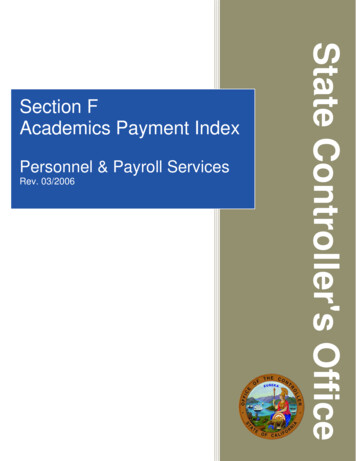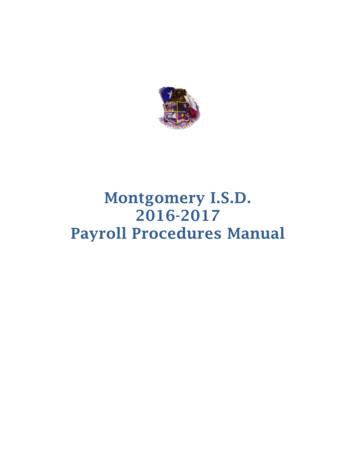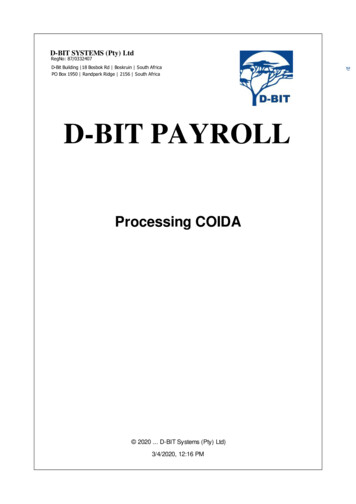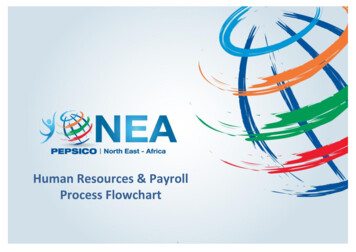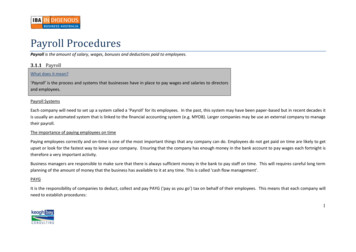
Transcription
Payroll ProceduresPayroll is the amount of salary, wages, bonuses and deductions paid to employees.3.1.1 PayrollWhat does it mean?‘Payroll’ is the process and systems that businesses have in place to pay wages and salaries to directorsand employees.Payroll SystemsEach company will need to set up a system called a ‘Payroll’ for its employees. In the past, this system may have been paper-based but in recent decades itis usually an automated system that is linked to the financial accounting system (e.g. MYOB). Larger companies may be use an external company to managetheir payroll.The importance of paying employees on timePaying employees correctly and on-time is one of the most important things that any company can do. Employees do not get paid on time are likely to getupset or look for the fastest way to leave your company. Ensuring that the company has enough money in the bank account to pay wages each fortnight istherefore a very important activity.Business managers are responsible to make sure that there is always sufficient money in the bank to pay staff on time. This will requires careful long termplanning of the amount of money that the business has available to it at any time. This is called ‘cash flow management’.PAYGIt is the responsibility of companies to deduct, collect and pay PAYG (‘pay as you go’) tax on behalf of their employees. This means that each company willneed to establish procedures:1
to correctly calculate how much tax is to be paid by each employee; to retain the tax withheld by the company on behalf of the Australian Taxation Office (ATO); to record how much the employee was paid and the amount of PAYG retained; and to correctly forward the tax retained to the ATO each quarter (or whatever period is agreed with ATO) on behalf of each individualemployee. The ATO allocates a Tax File Number for each employee that the company should use in all correspondence with the ATO.Many businesses will either employ an experienced payroll clerk to manage their payroll, or will use an external payroll company. Advice for employers onwhich tax rates they should use in paying their employees PAYG can be found at:http://www.ato.gov.au/Rates/Tax-tables/ SuperannuationSuperannuation is a regular payment made into a fund by an employee and an employer towards a future retirement pension. Under Australian law allemployers must pay superannuation contributions for their employees, at a minimum rate of 9% of their ordinary time wages.Employers have to pay super for an employee if they're between 18 and 69 years old and they are paid 450 or more (before tax) in salary or wages in amonth. It doesn't matter whether the employee is full time, part time or casual. Employees who are under 18 years old must work at least 30 hours perweek to be entitled to superannuation.Employers must pay contributions for each employee into a complying super fund and pass on your employee's tax file number (TFN) to their super fundwhere you are required to do so. Employers have to make superannuation payments at least four times a year. The cut-off dates are 28 days after the endof each quarter.All companies must therefore keep superannuation records that show: the amount of super paid for each employee and how it was calculated. that you have offered your eligible employees a choice of super fund. how you calculated any reportable employer super contributions.Further information on superannuation can be found at:2
quirements/ What are key Payroll controls?Many payrolls, even small ones, are now automated, so it is easier to commit fraud or errors if the internal controls are not set or followed. Key payrollcontrols are as follows:Separation of duties - A major step business owners can take to ensure proper payroll processing is to have different people performing key payroll duties.For example, employees should not process or approve actions affecting their own pay.Best practice is to have different people: prepare and update payroll and personnel data; approve payroll actions; review monthly payroll expense reports; review and reconcile payroll records on a monthly basis; and distribute the payroll.Management controls - The role of managers in a small business environment is to authorise and review payroll entries and ensure that personnel followpolicy. Managers should review monthly payroll costing reports, compare actual payroll costs to estimated costs and identify and explain differences.Privacy – Businesses should maintain data confidentiality by giving access to payroll and personnel information only to authorised individuals.Reconciliation - Payroll costs may represent the largest cost component of a business’s budget. Monthly reconciliation activities ensure that the rightpeople are being paid at the correct rates.See Appendix E5 for example payroll procedures.E5Example Financial Procedures – Payroll Procedures3
How to use this templateThis document is an example of the procedures that an Indigenous business could introduce to assist in the managing its payroll. It is important to note thatthe nature and complexity of such financial procedures may vary depending on the specific financial risks in the business and the size of the companyconcerned. However, this template procedure provides an example that a company can then tailor to their own needs.Note - This document is an example and may not be appropriate for all businesses.Procedural Instructions - Payroll1) Payroll Security1.1) All payroll staff should maintain security over payroll system passwords and the finance managershould change them regularly (e.g. monthly or quarterly).1.2) Maintain security over personnel data and files. Lock in secure cabinets.2) Basic Payroll Procedures2.1) Payroll staff should liaise with HR to maintain accurate employee attendance, pay scale and bankaccount records.2.2) The Payroll Manager / Supervisor should undertake regular reviews of the pay scales of employeesto ensure that they are correct and that fraud and error are eliminated.2.3) Payroll staff should ensure that the time records for hourly-paid employees are approved by asupervisor prior to their being passed for payment.2.4) Payroll staff should maintain complete and accurate payroll records for holiday and sick leave4
Procedural Instructions - Payrollentitlements and leave used.2.5) HR should ensure that staff are aware of the process for requesting and approving holiday or sickleave. Payroll staff should be provided with up to date and accurate information to enable themto ensure that payroll system properly reflects all employee absences.2.6) The Payroll Manager / Supervisor should review and authorise the payroll report in advance ofpayment being made to ensure that any errors, duplicate payments or omissions are corrected.2.7) Where possible, payroll staff should make salary / wage payments to staff through direct bankdeposits rather than cash or cheques. These bank transfers should be set up using the bank BDBand account number provided by new employees to the HR department on commencement ofemployment.2.8) In circumstances where cheques are issued to employees rather than bank transfers, any payrollcheques will be approved, signed and distributed by a designated manager.2.9) Payroll staff should investigate the reasons why any payroll cheques are unclaimed. The reasonsshould be reported to the Payroll Manager / Supervisor.2.10) The Payroll Manager / Supervisor should review all bank account deposits to ensure that each paygoes to a different bank account.2.11) The Payroll Manager / Supervisor should check the budgeted figure against payroll actual figure5
Procedural Instructions - Payrolland investigate variations. Any significant instances of fraud or error should be reported to theCFO immediately.3) Reconciliation procedures3.1) The payroll system should be reconciled to the financial ledger on a weekly basis. Any variationsshould be investigated and the reasons reported to the CFO. The reconciliation report should bereviewed and signed off by the Payroll Manager.4) Procedures to prevent payroll fraud4.1) The CFO should ensure that training has provided to different finance staff to ensure that morethan one person can process the payroll. This will provide cover for holidays or sick leave for theprimary payroll clerk, but will also enable job rotation which reduces risks of fraud.4.2) The Payroll Manager should seek to separate payroll preparation, payment and authorisationduties. In smaller organisations where this is not practical, the payroll report should be reviewedand authorised by the Finance Manager prior to payment being made.4.3) The same staff members should not perform the duties of personnel records managementand payroll.4.4) The Finance Manager should on a bi-monthly basis review the payroll register againstactual employees to confirm that no ‘phantom’ employees are being paid.4.5) Where sales staff are paid on a commission basis, the payroll staff should check any sales6
Procedural Instructions - Payrollactivity claimed by sales staff against the records of sales. Care should also be taken toensure that sales staff are not claiming more than once against a sale transaction.4.6) Weekly payroll reports should be provided to the Finance Manager or CEO whichhighlight any payments made to new employees or any payroll payments over a specificlimit (e.g. 2,000).7
Payroll Procedures Payroll is the amount of salary, wages, bonuses and deductions paid to employees. 3.1.1 Payroll What does it mean? ‘Payroll’ is the process and systems that businesses have in place to pay wages and salaries to directors and employees. Payroll Systems Each compan
